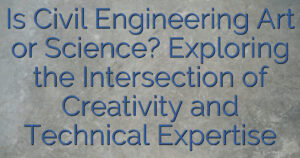
Civil engineering is a discipline that deals with the design, construction, and maintenance of the built environment.
It involves the application of scientific and mathematical principles to solve real-world problems related to infrastructure, transportation, water supply, and other aspects of modern life.
However, the question of whether civil engineering is an art or a science has been a subject of debate among professionals and academics.
Some argue that civil engineering is primarily a science, as it involves the use of empirical data, mathematical models, and scientific methods to design and construct structures that meet specific requirements.
Others contend that civil engineering is also an art, as it requires creativity, imagination, and aesthetic sensibility to produce structures that are not only functional but also visually appealing.
In reality, civil engineering is both an art and a science, and the interplay between these two aspects is what makes it such a fascinating and rewarding field.
Table of Contents
Key Takeaways – Is Civil Engineering Art or Science
- Civil engineering is a discipline that involves the application of scientific and mathematical principles to solve real-world problems related to the built environment.
- The question of whether civil engineering is an art or a science has been a subject of debate among professionals and academics.
- In reality, civil engineering is both an art and a science, and the interplay between these two aspects is what makes it such a fascinating and rewarding field.
Understanding Civil Engineering
Civil engineering is a field that involves the design, construction, and maintenance of infrastructure projects. These projects include a wide range of public works such as roads, bridges, tunnels, dams, airports, and buildings. Civil engineers use their knowledge of mathematics, physics, and other sciences to design and develop these projects.
The field of civil engineering is a combination of both art and science. While civil engineering is based on scientific principles, it also requires a great deal of creativity and innovation. Civil engineers must consider a wide range of factors when designing and building infrastructure projects, including safety, environmental impact, and cost-effectiveness.
One of the key aspects of civil engineering is the ability to work with a team of professionals from different disciplines. Civil engineers must collaborate with architects, construction workers, and other professionals to ensure that infrastructure projects are completed on time, within budget, and to the highest standards of quality.
Civil engineering is also a field that is constantly evolving. New technologies and materials are constantly being developed, and civil engineers must stay up-to-date with these changes to ensure that they are providing the best possible solutions for their clients.
Overall, civil engineering is a field that requires a combination of technical knowledge and creative problem-solving skills. Civil engineers play a crucial role in shaping the world around us, and their work has a significant impact on our daily lives.
Civil Engineering as a Science
Civil engineering is a branch of engineering that deals with the design, construction, and maintenance of the built environment, including structures such as buildings, roads, bridges, and water and sewage systems. Although civil engineering involves artistic elements, it is primarily a science-based discipline that relies on scientific principles, technical skills, and analytical thinking.
Scientific Principles
Civil engineering is based on a foundation of scientific principles that are used to design and construct structures that are safe, efficient, and sustainable. These principles include physics, mathematics, and mechanics, which are used to calculate the structural integrity of buildings and bridges, the load capacity of roads and highways, and the flow of water and sewage systems.
Technical Skills
Civil engineers use a variety of technical skills to design and construct structures that meet the needs of society. These skills include computer-aided design (CAD), geographic information systems (GIS), and building information modeling (BIM). CAD software is used to create 2D and 3D models of structures, while GIS is used to analyze and manage spatial data. BIM is used to create digital representations of buildings and structures, which can be used to simulate and test their performance.
Analytical Thinking
Civil engineers use analytical thinking to solve complex problems related to the built environment. They must be able to analyze data, identify patterns, and develop solutions that are safe, efficient, and cost-effective. They must also be able to communicate their findings to other professionals, such as architects, contractors, and government officials.
In conclusion, civil engineering is primarily a science-based discipline that relies on scientific principles, technical skills, and analytical thinking. While artistic elements may be present in civil engineering, it is the science behind the design and construction of structures that makes it a unique and valuable field.
How Does Traffic Engineering Factor into the Intersection of Creativity and Technical Expertise in Civil Engineering?
The intersection of creativity and technical expertise in civil engineering is crucial as it bridges the gap between functionality and aesthetics. Traffic engineering plays a significant role in this balance, considering the civil and traffic engineering differences in managing flow while ensuring safety and efficiency at intersections.
Civil Engineering as an Art
Civil engineering is often considered a science, but there is also a strong argument that it is an art form. While it is true that civil engineering requires a deep understanding of physics, mathematics, and other scientific fields, it also requires a significant amount of creativity and aesthetic consideration. In this section, we will explore some of the ways that civil engineering can be considered an art.
Creative Design
One of the most obvious ways that civil engineering is an art is through the creative design process. Civil engineers must design structures that are both functional and aesthetically pleasing. This requires a significant amount of creativity and innovation. Engineers must consider the materials they use, the shapes of the structures, and the overall visual impact of the design.
Aesthetic Consideration
In addition to creative design, civil engineering also requires a significant amount of aesthetic consideration. Engineers must consider the visual impact of their structures on the surrounding environment. They must consider how the structure will fit into the landscape and how it will interact with other structures in the area. This requires a deep understanding of color theory, composition, and other artistic principles.
Innovative Solutions
Finally, civil engineering can be considered an art form because it often requires innovative solutions to complex problems. Engineers must think outside the box and come up with creative solutions to challenges that arise during the design and construction process. This requires a significant amount of creativity and ingenuity.
In conclusion, civil engineering is not just a science, but also an art form. Engineers must be able to think creatively, consider aesthetics, and come up with innovative solutions to complex problems. By combining scientific knowledge with artistic principles, civil engineers are able to create structures that are not only functional but also beautiful.
Interplay of Art and Science in Civil Engineering
Civil engineering is a field that requires both artistic and scientific skills. The interplay between these two disciplines is essential in creating structures that are both functional and aesthetically pleasing. In this section, we will explore how art and science work together in civil engineering.
Balancing Functionality and Aesthetics
Civil engineers must balance the functionality and aesthetics of their designs. They must ensure that their structures are safe, durable, and meet the needs of their clients. At the same time, they must also consider the visual appeal of their designs. Aesthetics play a crucial role in the success of a project, as they can influence public perception and even property values.
To achieve this balance, civil engineers must have a deep understanding of both art and science. They must be able to apply scientific principles to their designs while also incorporating artistic elements. This requires a high level of creativity and technical skill.
Incorporating Science in Design
Science plays a significant role in civil engineering. Engineers use scientific principles to design structures that are safe, efficient, and sustainable. They must consider factors such as the properties of materials, environmental conditions, and the forces that act on structures.
To incorporate science into their designs, civil engineers use advanced software and modeling tools. These tools allow them to simulate the behavior of structures under different conditions, such as earthquakes or high winds. By using these tools, engineers can optimize their designs for safety and efficiency.
In conclusion, civil engineering is both an art and a science. The interplay between these two disciplines is essential in creating structures that are both functional and aesthetically pleasing. Civil engineers must balance the functionality and aesthetics of their designs while incorporating scientific principles. By doing so, they can create structures that are safe, efficient, and visually appealing.
Real-World Examples of Civil Engineering as Art and Science
Civil engineering is both an art and a science. It requires technical expertise and creativity to design and build structures that are not only functional but also aesthetically pleasing. Here are some real-world examples of civil engineering as both an art and science.
Iconic Structures
Civil engineers have been responsible for designing and constructing some of the world’s most iconic structures. One such example is the Golden Gate Bridge in San Francisco, California. The bridge is not only a feat of engineering but also a work of art. Its iconic orange color and graceful lines make it one of the most recognizable structures in the world.
Another example of civil engineering as art is the Burj Khalifa in Dubai, United Arab Emirates. The Burj Khalifa is the tallest building in the world and required innovative engineering solutions to ensure its stability and safety. Its sleek design and impressive height make it a true work of art.
Sustainable Designs
Civil engineers are also responsible for designing structures that are sustainable and environmentally friendly. One example of this is the Bullitt Center in Seattle, Washington. The Bullitt Center is a six-story office building that is completely powered by renewable energy sources such as solar power and geothermal energy. It also features rainwater harvesting, composting toilets, and other sustainable design elements.
Another example of sustainable civil engineering is the High Line park in New York City. The High Line is a public park built on an abandoned elevated railway track. It features native plants, sustainable stormwater management systems, and other environmentally friendly design elements.
In conclusion, civil engineering is both an art and a science. Civil engineers must use their technical expertise and creativity to design and construct structures that are not only functional but also aesthetically pleasing and environmentally friendly. The examples above demonstrate how civil engineering can be both innovative and sustainable while still being beautiful and functional.
